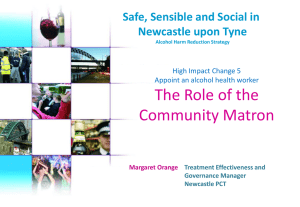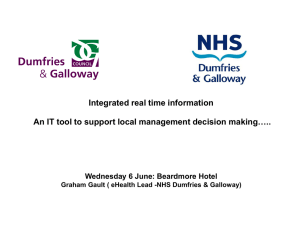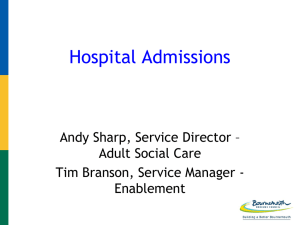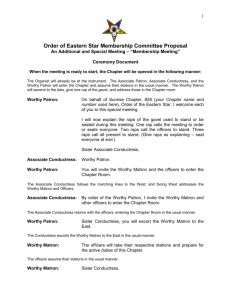Generalist Community Matrons
advertisement
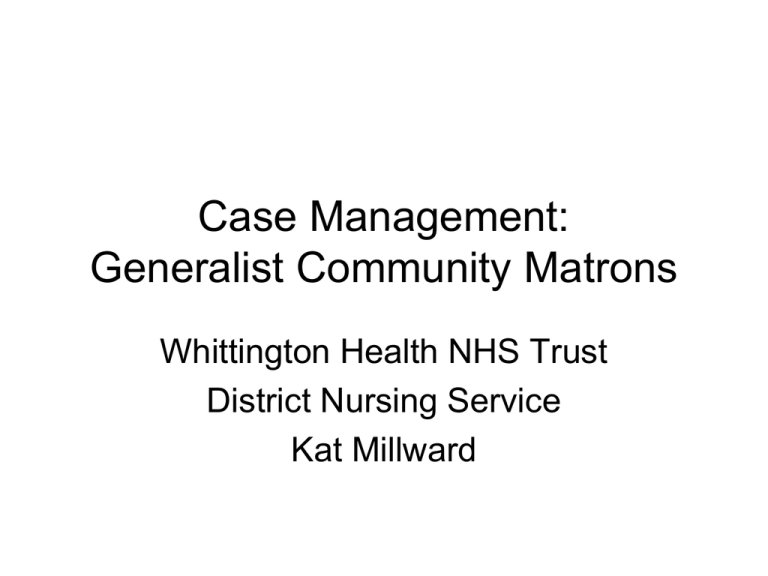
Case Management: Generalist Community Matrons Whittington Health NHS Trust District Nursing Service Kat Millward Overview • Why the Community Matron role was created • Definitions of case management and community matron • My personal perspective on case management • Patient case studies History • Chronic diseases are the biggest cause of disease burden, disability and death across the world. • Internationally, it is a policy priority to improve the experience of, and service delivery to, people with long term conditions and their carers through multidisciplinary models of chronic disease management (Challis et al. 2010). History 2 • Case management based on Evercare Model from USA with Kaiser Pyramid risk stratification tool (Lewis 2011; Woodend 2006) History 3 • The British population is ageing and health problems are changing • We need new and creative approaches to health, care and support systems to meet the needs resulting from these changes. • As more people live into older age we need services that support people to remain as well as possible for as long as possible within their own homes and communities. • The ambition is to – increase the healthy years of life – reduce the social isolation that many older people experience – improve the quality of their lives (DH, 2013) History 4 • the involvement of community matrons aims to improve health outcomes and reduce emergency bed days (DH 2006). • DH suggested case loads of approximately 50 patients based on this model. Definitions Case management- a collaborative process which • assesses, • plans, • implements, • co-ordinates, • monitors and • evaluates the options and services required to meet an individual’s needs. This may be related to health, social care, education, and employment (Challis et al. 2010) Ooh Matron! (definitions 2) • ‘old’ Matron role different to ‘new’ or ‘Modern’ Matron • Community Matron – different role altogether. • CM could be seen as Older Adult Nurse Specialist Definitions 3 Community Matron • A community matron is a nurse who provides advanced clinical nursing care as well as case management to an identified group of very high intensity users (DH 2005). • Experienced nurses, with advanced practice skills, using case management techniques with patients who have chronic diseases and very high intensity use of health care. The aim is to support the patients to manage their conditions, remain in their own homes, and avoid unplanned admissions to hospital (Challis et al. 2010) Case management Social Services Hospital Specialist 3 Housing GP Third Sector Patient Hospital Specialist 1 Hospital Specialist 2 CNS 2 CNS 1 Equipment provider Allied Health (OT, physio) Personal perspective in Islington Caseloads between 20-45 (ideal would be 30) Balance of direct patient care (health monitoring & chronic disease management; acute episodes) and coordination/liaison away from patient Often working with hard to reach populations & previous non-engagement with health Personal perspective in Islington 2 • 3-4 face to face visits each day • MDT working – monthly teleconference, – GP meetings, – case conferences • Clinical advice and support to DN and other staff • In office – referrals, – liaison, – care planning Personal perspective in Islington 3 Positives • Autonomous role • challenging & varied • Close historic ties with social services • Advanced nursing skills • Holistic care • Building professional networks Personal perspective in Islington 4 Needing work • Communication in both directions • Information technology • Integrated working • Engagement (patients, other professionals) • how to predict patient engagement Case studies of effective working Rob Medical history: Diabetes, heart failure, bilateral amputee, lymphoedema, catheterised, abdominal mass Before: hospital admissions every 4-6 weeks with worsening heart failure, urinary infection or chest infection After: Only 1 unplanned admission in 6 months Decreasing admissions through assessment, early treatment &social care Case studies of effective working Brian Medical History: TB, COPD, cognitive impairment (amnesia-dominant dementia) Before: 36 ED attendances in 3 months After: 5 ED attendances in 3 months Reducing admissions through communication, forward planning, PSP, flexible approach Case studies of effective working Tony Medical History: COPD, mild learning disability, cognitive impairment (undiagnosed dementia), alcohol dependence Before: 3-4 ED attendances each month After: 4 ED attendances in past four months Increasing engagement, decreasing unplanned admissions through liaison, supporting to attend appointments, regular monitoring and social issue resolution Case studies of effective working Donna Complex medical history, long admissions to hospital, multiple specialists Medical history: pulmonary hypertension, interstitial lung disease, rheumatoid arthritis, heart failure, obesity, sleep apnoea, oxygen dependent Before: Between September 2012 and April 2013 spent approximately 3 weeks at home After: No unplanned admissions. Has had 3 overnight planned admissions for investigations Questions? References • • • • • • Challis, D., Hughes, J., Berzins, K., Reilly, S., Abell, J. & Stewart, K. (2010). Self-care and case management in long-term conditions: the effective management of critical interfaces. Report for the National Institute for Health Research Service Delivery and Organisation programme. London: HMSO Department of Health. (2006). Caring for people with long term conditions: an education framework for community matrons and case managers. London: HMSO Department of Health. (2013). Care in local communities - district nurse vision and model. London: HMSO Grange, M. (2011). ‘How community matrons perceive their effectiveness in case management’. Nursing Older People. 23(5), 24-9 Lewis, G. (2011). ‘Guess who’. The Health Service Journal. 121(6279), 23-5 Woodend, K. (2006). ‘The role of community matrons in supporting patients with long-term conditions’. Nursing Standard. 20(20), 51-54.

